|
MOUNTAIN BIKE TECHNIQUE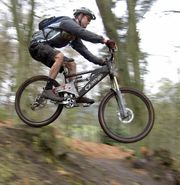
I did my first mountain bike ride on a recreational trek bike at a local trail and had no mountain bike technique. I was hooked, but had a lot to learn. I would fall almost every trip. I guess that means I was pushing the limits. My husband was hilarious and did very entertaining endos! This is a compilation of mountain bike techniques that will help you learn how to handle the trail. Mountain biking is an endeavor that is fun and a few simple techniques can help you get so much better. SIGHT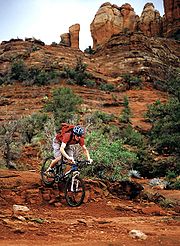
Look at where you actually want to go, rather than the trail beneath you. Looking at something you do not want to hit is like guaranteeing that you will hit it. Look ahead, down the trail to where you are going, as where you look is where your wheels will take you. This more than any other tip will help you. Unfortunately it is the hardest to do. Try to scan about 30 ft in front of you. Keep your head up scanning the trail for your line (where you are going to ride). Your tires will follow you. Jesse James even did a scientific test. Though he did it in an off road vehicle, it was proven that you do indeed go where you look. It is also important to pick a line. Think several steps ahead and pick where you are going. Then look at where you are going. Now is the hard part, keep scanning ahead and pick the next line. Your eyes should always be scanning. This will become second nature after a while. Once you pick your line go for it. Do not change your mind. It is better to pedal through it, if you picked a poor line. It is easier to roll with it than to try to adjust which can result in a fall. DESCENDING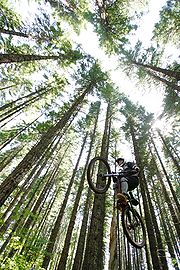
When descending, you should put your weight back, using the neutral position as the ideal starting point. This can either be a subtle shift of the weight, or a more extreme shift. You should lift yourself up off the saddle and move back as a means of lowering your center of gravity, and keep in mind when descending that speed is best as long as you do not ride without control. On something really steep you may ride so far back your bottom is over the tire. This takes some getting used to, but you'll have so much better control. If you are skidding because you cannot slow down while descending, you are probably riding out of control. Slow down a bit and get under control. Stay loose and flexible, and with your heels down. MOUNTAIN BIKE TECHNIQUE: CLIMBING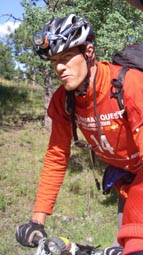
Climbing is an excellent test of fitness and persistent. Standing tends to be ineffective when you are climbing a long, steady trail. Save your standing energy for final pushes over obstacles, around switchbacks, to crest a rise, or for short and steep sections. Occasionally on a long climb you'll need to stand to keep momentum. You should stay seated and take advantage of a long leg extension and a manageable pace if possible. If the climb is steeper, then you should get your weight forward while going. If not you may spin the front tire out. Be sure and hit the proper gear before you are pushing the pedals hard. Begin to gear down as you hit the hill. Aim for a cadence of 60-90 rpms. If you have trouble climbing it may be because you are having difficulty finding your center, or that you are having trouble balancing yourself. Or you could just be out of shape! It takes some practice getting used to climbing long steady hills. Try not to stop as getting started is hard as well on a hill. MOUNTAIN BIKE TECHNIQUE: BRAKING
The front brake makes up more than sixty percent of your braking capability and power. If you grab at your front brake hard, you are almost guaranteeing that you will flip over the front of your bike (check out picture!). To learn how to use your front brake you should practice going down slight slopes only using the front brake in order to slow your bike, just make sure that you do not skid or lose your balance. Be sure to shift your weight back when you use your front brake. If you lock your back brake up or push to hard, normally you'll just skid. It does not have near the consequences of slamming on your front brake! Do not use your entire hand to brake, but rather use only one or two fingers at a time. Be very careful that you do not do an endo and that the hill is not too steep for this practice. On a long descent pump the brakes. If you just bear down on them you could overheat them. Do not brake before going over obstacles keep on pedaling. Keep in mind that you can adjust your brakes to soften or tighten them if you want to change how much movement the lever is capable of having. MOUNTAIN BIKE TECHNIQUE: OBSTACLES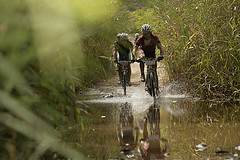
This mountain bike technique can be hard to master and you can practice on the road as well. It is important not to use all your gears when riding, especially on climbs, so that you have a little bit of extra power to deal with obstacles. Most obstacles can be avoided as long as you do not keep your eyes on them, so focus on the road ahead of you and keep going. Choose your line and look at the line not the obstacle. Make sure that you can build up extra momentum as needed in case you hit an obstacle that requires extra effort from you. If you hit one keep pedaling and keep momentum going and you should ride right over it. MOUNTAIN BIKE TECHNIQUE: SWITCHBACKS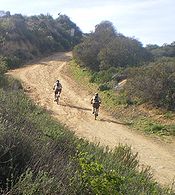
Look around the entire turn and continue moving, then look behind the turn's exit and move down the trail. Make sure that you remain in a neutral position the entire time, extending your legs without locking them, and then moving your body back slowly as you need to. As far as switchbacks are concerned, it is helpful to keep the bike as upright as you can, moving out of your saddle and moving your weight back with steeper climbs. Keep
practicing and learning new techniques
and you'll be flying around the trail in no time.  Mountain Bike Techniques: Book Return to Mountain Biking Riding from Mountain Bike Technique
|



